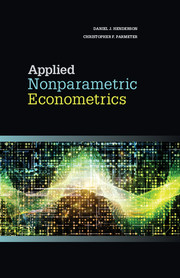Book contents
- Frontmatter
- Dedication
- Contents
- 1 Introduction
- 2 Univariate density estimation
- 3 Multivariate density estimation
- 4 Inference about the density
- 5 Regression
- 6 Testing in regression
- 7 Smoothing discrete variables
- 8 Regression with discrete covariates
- 9 Semiparametric methods
- 10 Instrumental variables
- 11 Panel data
- 12 Constrained estimation and inference
- Bibliography
- Index
9 - Semiparametric methods
Published online by Cambridge University Press: 05 February 2015
- Frontmatter
- Dedication
- Contents
- 1 Introduction
- 2 Univariate density estimation
- 3 Multivariate density estimation
- 4 Inference about the density
- 5 Regression
- 6 Testing in regression
- 7 Smoothing discrete variables
- 8 Regression with discrete covariates
- 9 Semiparametric methods
- 10 Instrumental variables
- 11 Panel data
- 12 Constrained estimation and inference
- Bibliography
- Index
Summary
Nonparametric methods are often criticized because of their need for large amounts of data. The study of economic growth is a prime example of where nonparametric methods are being stretched to their limits (Henderson, Papageorgiou, and Parmeter, 2012, 2013). Here a wide variety of covariates exist and at best the available sample size is moderate. Thus, issues regarding the accuracy and insightfulness of the results from nonparametric estimation/inference are in question. In the presence of dimensionality issues, we often resort to semiparametric methods, which place additional structure on the model.
While a variety of semiparametric methods exist, perhaps the most famous is the partially linear model (PLM), popularized in econometrics by Robinson (1988). In this model, some of the variables enter the conditional mean nonparametrically, while others enter in linearly. It is assumed that the groups of variables are separable from one another and estimation of each part can be obtained as a combination of OLS and the estimators from Chapter 5. The estimator for the nonparametric component generally converges at the standard nonparametric rate, albeit faster because we have fewer regressors, while the parametric estimator converges at the standard rate. It is this result that is the most appealing empirically regarding the PLM.
Both the statistical and econometric literature is rich in treatises on semiparametric estimation and inference. Our goal here is to provide a simple overview of many of the most common methods, paying careful attention to empirical implementation issues. We start with the aforementioned PLM and then discuss single-index models. The latter of these methods is often used for discrete-choice models, where you may be uncomfortable assuming a distribution for the errors, such as Gaussian (for probit), but are comfortable with the single-index framework. Afterwards we discuss semipara-metric smooth coefficient models (SPSCMs). Here the functional form is assumed to be linear in a given set of covariates while the coefficients are allowed to depend on another set of covariates in an unknown way. These methods are becoming increasingly popular in many applied economic milieus.
- Type
- Chapter
- Information
- Applied Nonparametric Econometrics , pp. 227 - 266Publisher: Cambridge University PressPrint publication year: 2015



